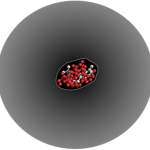nanotechnology
Scale, proportion, and quantity belong to one of the cross cutting concepts in the next generation science standards (NGSS). According to Volume 2 of the NGSS, "in engineering, no structure could be conceived much less constructed without the engineer's precise sense of scale." The authors go on to note that scale and proportion are best understood using the scientific practice of working with models.
When scientists and engineers work with these concepts at a molecular scale, new kinds of technologies can be created to advance our understanding of…
By Travis Earles, Lockheed Martin Senior Manager, Advanced Material and Nanotechnology Initiatives
“Imagination will often carry us to worlds that never were.”
-Carl Sagan, famed astronomer, astrophysicist and cosmologist
Imagine a world where we have the ability to understand and control matter at the nanoscale, where unique phenomena enable novel applications. A world where novel materials enable entirely new approaches to design and production that is faster and better than ever before.
The nanotechnology exhibits at the upcoming USA Science & Engineering Festival will provide a…
Could we have taken action earlier to prevent harm from tobacco, asbestos, and lead? That's the question at the core of the European Environment Agency's (EEA) collection of case studies, which was released this month as Volume 2 "Late lessons from early warnings: science, precaution, innovation."
The publication features articles on those nefarious health hazards, as well as ones about beryllium, Bisphenol A, the pesticides DBCP and DDT, mercury, perchlorethylene, and vinyl chloride. Protecting ecosystem, including aquatic environments exposed to ethinyl oestradiol (synthetic…
When biomedical engineering scientist Erin Lavik received the prestigious New Innovator Award last year from the National Institutes of Health for her work in advancing the development of synthetic (artificial) blood platelets, she was already becoming known in biomedical circles as a rising researcher.
Erin's laboratory at Case Western Reserve University, where she is currently an associate professor of Biomedical Engineering, was attracting attention for its focus on developing new approaches to understand and treat hemorrhaging, spinal cord injury, glaucoma, and diseases of the retina…
A shout out to Vincent Caprio for posting this interview with Larry Bock and blogging about the festival on his website. Thanks for helping us get the word out!
NanoBusiness Alliance Interview - Larry Bock, Executive Director, USA Science & Engineering Festival
Posted on September 1st, 2010
This month's interview, 6th in our series, is with Larry Bock, icon of the Nanotechnology Community. I had the pleasure of meeting Larry in Washington, DC in February 2002. We walked the Halls of Congress together and Larry was one of the key players in advocating for the National Nanotechnology…
MAGNETIC nanoparticles targeted to nerve cell membranes can be used to remotely control cellular activity and even the simple reflex behaviours of nematode worms, according to research by a team of biophysicists at the University of Buffalo. The new method, which is described in the journal Nature Nanotechnology, could be very useful for investigating how cells interact in neuronal networks, and may eventually lead to new therapies for cancer and diabetes.
Heng Huang and her colleagues synthesized manganese-iron nanoparticles, each just 6 millionths of a millimeter in diameter, and coated…
We keep writing about the risks involved with nanotechnology, so it's nice to be able to highlight a potential benefit. Andrew Schneider reports for AOL News that researchers from the Australian Institute for Bioengineering and Nanotechnology have developed a "nanopatch" that can deliver vaccines more effectively than intramuscular injection:
[University of Queensland Professor Mark] Kendall told the Australian Broadcasting Corp. that the nanopatch is designed to place vaccines directly into the skin, where a "rich body of immune cells are." A needle, by contrast, injects vaccines into…
(Ten Best of the Decade from Half of the World's Fair)
This series began with the kindness of a friend who agreed to let me ask him about his book about Barry Commoner, science, and modern environmentalism. It then spawned a series of 17 interviews with authors of books in science studies, environmental history, the history of science, and all combinations in between. Every one of them was enjoyable to do; every author was generous and insightful. I've been able to use some of these as thumbnail sketches of readings I use in class. In that, they stand as the best example of blogging as a…
by Richard Denison, PhDÂ cross-posted from blogs.edf
In June, EPA published a Federal Register notice that included Significant New Use Rules (SNURs) for two carbon nanotubes (as well as 21 other chemicals). That notice certainly got the attention of lawyers in town (see here, here and here). The nanotube SNURs would require anyone planning to produce or process either of the two substances to notify EPA if the person intended not to comply with the (rather limited) risk management conditions specified by EPA. Well, as reported yesterday by Sara Goodman of E&E…
Three physicians and researchers from the Capital University of Medical Sciences (Beijing, China) have published a case report in the European Respiratory Journal describing severe lung disease in seven female workers employed at a shop where they applied polyacrylic coatings to polystyrene boards. The lung disease is just one part of the story---two of the women died (ages 19 and 29)---the other part is that pathology samples from the workers' lungs identified 30 nm (nanometer) in diameter particles. Further investigation found that the coatings…
Liveblogging from the Hi-Tec conference
I'm currently at the Hi-Tec conference in Scottsdale, Arizona. (If you follow me on Twitter - www.twitter.com/@digitalbio - you may have seen me complaining about the temperature). It's an interesting conference, so I'm going to share some of the things that I'm learning.
Dr. Travis Benanti and Dr. Steve Fonash from Penn State University are presenting an interesting session this morning on nanotechnology.
Luckily, you don't have to know anything about nanotechnology to find the session fascinating.
If you're interested in learning about nanotechnology…
As I noted last week, the Pew survey of scientists finds that more than 50% self-identify as liberals compared to just 20% of the public.
Which then leads to the question: what role does ideology play in shaping scientists' policy preferences relative to science, especially in those areas outside of their specialty? Or on those issues where there are high levels of uncertainty about risks, benefits, and trade-offs? Heuristic decision-making is common in politics and policymaking, are scientists as a group any different?
Put another way, in responding to the Pew findings, several commentators…
Investigative journalist Carole Bass has written extensively about nanotechnology, emphasizing how little we know about the risks associated with the nanoparticles now used in a wide range of consumer products, from sunscreen to stain-resistant clothing. Her latest piece, in the new issue of E Magazine, includes an exploration of what these particles do when they wash off our skin and clothing and go down the drain:
[Cyndee] Gruden, a civil engineering professor at the University of Toledo in Ohio, is tackling part of that last question by looking at the effects of two nanometalsâtitanium…
by Kas
Introduction
The National Nanotechnology Initiative (NNI) coordinates Federal R&D activities related to nanotechnology. Currently, the NNI involves the activities of 25 Federal agencies, 13 of which have budgets planned for 2010. Four of these agencies have specific responsibilities to address environmental, health, and safety (EHS) nanotechnology research needs as outlined by the 2008 NNI publication Environmental, Health, and Safety Research Needs for Engineered Nanoscale Materials. The four agencies are: USEPA, NIOSH, NIST, and NIH (thatâs the Environmental…
Weâve written before about the way that use of nanomaterials in consumer products is outpacing research on the materialsâ occupational and environmental health effects. So, itâs good to see that the National Institute for Occupational Safety and Health is contributing a piece to the puzzle, and getting the word out to the public about their research.
NIOSH scientists Vincent Castranova, Ann Hubbs, Dale Porter, and Robert Mercer conducted a study in which laboratory mice inhaled liquid containing multi-walled carbon nanotubes (MWCNTs). Attendees at last weekâs Society for Toxicology meeting…
The latest piece from Rick Weiss at Science Progress is a must-read for anyone concerned about the safety of nanotechnology. Weiss attended a conference sponsored by the Food and Drug Law Institute where lawyers provided advice about avoiding nanotech-related lawsuits, and learned this:
In short, if you are a nanotech company you need to start developing a legal strategy for âhow to protect yourself,â summarized Henry Chajet, an attorney with Patton Boggs. Listening, I felt sheepish for thinking it was about how to protect your employees and customers. â¦
One of the best ways to…
The University of Wisconsin news office has posted a valuable Q&A with my friend and UW professor Dietram Scheufele. The occasion is a new study he has published with colleagues at Nature Nanotechnology, examining the relationship between the social background of audiences and their views on the moral acceptability of nanotechnology, comparing perceptions in the US to Europe.
The interview hits closely on some of the major themes Scheufele and I cover in a manuscript that provides a big picture view on new directions in science communication. Here's a key excerpt from the interview:
WW…
Japanese researchers have developed a design concept for a light microscope which could in principle be used for imaging of nanoscale objects. The device would rely on a novel subwavelength imaging technique which allows for the visualization of objects that are smaller than the wavelength of the photons used in the device.
Once thought to be impossible, subwavelength imaging can now be performed because of the development of nanostructured metamaterials with a negative refractive index, which can act as a lens by focusing incident light. Until now though, such materials only worked at one…
A news release on a new survey from the Woodrow Wilson Center's project on nanotechnology:
Washington, DC -- A groundbreaking poll finds that almost half of U.S. adults have heard nothing about nanotechnology, and nearly nine in 10 Americans say they have heard just a little or nothing at all about the emerging field of synthetic biology, according to a new report released by the Project and Peter D. Hart Research. Both technologies involve manipulating matter at an incredibly small scale to achieve something new....
Synthetic biology is the use of advanced science and engineering to…
The Woodrow Wilson Center released a report on engineered nanomaterials used for food applications. The aren't common (we think), but there are a few technologies that are making their way to the market. One for instance would have a nanofilm that has anti-microbial properties. Of course, it may also leach into your food. Yum! (Okay, it probably wouldn't taste any different but untested films don't sit that well with me.)
One of the things I love about these type of reports on emerging threats/risks is how they put a bunch of options on the table for industry and regulators as if they are all…

